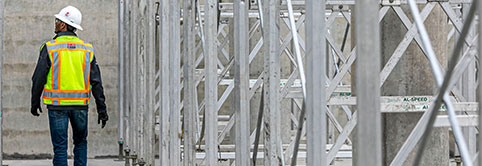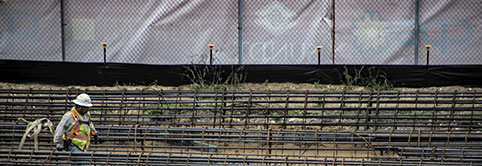Just-in-time (JIT)
Introduction to Just-in-time
At the Lean Construction Institute, we have identified 8 types of waste that occur in construction projects. In short, waste is anything that doesn’t create value. One of those types of waste, Unnecessary Transportation, can be addressed effectively using Just-in-time management.
Unnecessary Transportation is defined as the transporting of materials, tools, or people before they are needed or in higher quantities than they are needed, or more often than needed. This can lead to poor organization in the workplace, which in turn can cause worker injuries when tripping over misplaced items or creating ways to work around materials in the way, wasted time while workers sort through the excess material, and defects when these materials get damaged or lost while waiting to be used.
Just-in-time material management aims to solve this problem by helping teams better organize their material management and transportation logistics.
What is Just-in-time (JIT)?
Just-in-time is a materials management strategy that aligns the construction schedule with the inventory transportation schedule to ensure that workers are receiving materials only when they are needed (or at the last responsible moment), reducing waste in the process.
Why Overstocking is Common
Overstocking is the act of ordering more materials than you reasonably need to complete a task in a specific time frame. This is common in the construction workplace as it can be tempting to place bulk material orders at once and deprioritize the organization of those items when they arrive or figure that the organization piece can be worked out later.
However, without a proper 5S system for material organization, properly organizing those materials is often forgotten entirely. Even if 5S is implemented, a lot of time will be wasted sorting excess materials – when sorting time would be greatly reduced if materials arrived in the right quantities at the time they are needed or just in time.
Similarly, many teams will order an excess amount of buffer materials because it’s “better to be safe than sorry.” However, unused materials turn into multiple forms of waste, and this approach actually creates more problems than taking what you may consider the “risky” approach of just ordering what you need, when you need it, and in the quantities needed.
What if I'm Sourcing Materials From Far Away?
Where you source your materials from can play into these very complex decisions, and may make it more tempting to overstock. For example, project teams ordering materials from a manufacturer far away may try to play it safe by placing a large order early to avoid having to wait on the materials being sent.
There are three main solutions that can enable you to continue using Just-in-time practices without your project suffering.
1. Source Locally
This is a great opportunity to begin sourcing your materials locally, whether that means receiving materials from a nearby manufacturer or manufacturing materials on your own (another great idea!) Sourcing materials locally will enable you greater control over the shipping schedule of materials and will allow you to make on-the-fly changes with minimal consequence.
2. Rent Local Warehouse Space
Another option is to rent out warehouse space to hold and sort through your materials. That way, you can have total access to your materials upfront, enabling you to identify broken or faulty materials early in the process (before you need them). Renting warehouse space also allows your team total control over when and where materials are delivered to the jobsite.
However, if you go with this approach it is crucial you maintain 5S best practices to keep the space organized and tidy and aligned with Lean practices.
While this method may seem counterintuitive to budget considerations, teams find that the positive impact of a well-thought-out approach results in actual savings through the elimination of other critical wastes.
3. Stay Vigilant
If your team needs to continue sourcing materials from a far-away distributor and can’t afford to pay for the costs of a warehouse, Just-in-time management can still be utilized if the person in charge of logistics stays on top of ordering and delivery schedules and commits to a 5S organizational system that allows you to monitor inventory closely.
How to Implement Just-in-time
1. Material Sourcing
Will you be self-performing manufacturing, or will you be having them shipped in? If you are going to be working with outside manufacturers, do your research to ensure that they’re a company you can trust to work with your JIT strategy and complete orders on time – a late or damaged shipment of goods can cause a lot of problems for a team using Just-in-time management.
2. Communication
Make sure there is a strong line of communication between your manufacturer, your on-site inventory manager, and the other team leaders responsible for construction. To make Just-in-time effective, your team leaders need to effectively communicate what materials they need and when to the on-site personnel in charge of material logistics and deliveries.
3. Inventory Management
Implement a sound inventory management system using 5S. Being able to accurately sort through all of your existing inventory will help keep your material orders as small as possible while ensuring your team is able to set up everything you need for the day’s work in time.
4. Keep Buffer to a Minimum
Determine how much buffer material you need. There’s always a risk that materials will get damaged during transit, so it’s natural to plan ahead by ordering a little more than you need. If you’re using Just-in-time inventory management for the first time, you can start with more buffer and slowly trim the amount of buffer requested in future orders as you get more comfortable with the system.
Benefits of Just-in-time
1. Increases Efficiency
It’s no secret that a pull planning system makes processes more efficient – just ask the Toyota Production System! Just-in-time management will keep waste to a minimum, making more room for value and increasing efficiency.
2. Reduces Waste
With less unnecessary transport, fewer material defects, lowered wait times, and decreased excess inventory, Just-in-time eliminates waste in a number of different crucial ways, leading to a more valuable end result.
3. Places Emphasis on Quality Control
With fewer materials coming in, the team is forced to ensure that the materials that do come through are of high quality. This increased focus on quality control will allow the team to catch mistakes and defects early.
4. Decreases Warehouse Costs
By having materials delivered directly to the jobsite when they’re needed, warehouse costs are kept down. This can lead to more savings on the total cost of the project.
5. Gives Team Leaders More Control
More organization = more control. Project managers will be more able to manage the flow of materials to where they need to go if they don’t also have to worry about organizing a large number of excess materials.
Lean Assessments
How strong is your Lean knowledge? Take a Lean assessment to determine your current state so you have a baseline for improvement. Lean assessments are available for individuals, teams, and organizations alike. Whether you’re new to Lean or are an experienced Lean practitioner, Lean assessments are a great way to get started at LCI!
TAKE ASSESSMENTMore Lean Topics
From 5s to IPD, explore popular Lean design and construction topics below.




